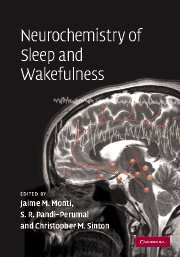Book contents
- Frontmatter
- Contents
- List of contributors
- Preface
- Acknowledgements
- Abbreviations
- I The neurochemistry of the states of sleep and wakefulness
- II The influence of neurotransmitters on sleep and wakefulness
- 4 Gamma-aminobutyric acid and the regulation of paradoxical, or rapid eye movement, sleep
- 5 Acetylcholine modulates sleep and wakefulness: a synaptic perspective
- 6 Histamine in the control of sleep–wakefulness
- 7 Dopamine in behavioral state control
- 8 Glutamate neurotransmission and sleep
- 9 Serotonin and sleep–wake regulation
- III Changing perspectives
- Index
- Plate section
4 - Gamma-aminobutyric acid and the regulation of paradoxical, or rapid eye movement, sleep
from II - The influence of neurotransmitters on sleep and wakefulness
Published online by Cambridge University Press: 23 October 2009
- Frontmatter
- Contents
- List of contributors
- Preface
- Acknowledgements
- Abbreviations
- I The neurochemistry of the states of sleep and wakefulness
- II The influence of neurotransmitters on sleep and wakefulness
- 4 Gamma-aminobutyric acid and the regulation of paradoxical, or rapid eye movement, sleep
- 5 Acetylcholine modulates sleep and wakefulness: a synaptic perspective
- 6 Histamine in the control of sleep–wakefulness
- 7 Dopamine in behavioral state control
- 8 Glutamate neurotransmission and sleep
- 9 Serotonin and sleep–wake regulation
- III Changing perspectives
- Index
- Plate section
Summary
Paradoxical sleep: the early years
In 1959, Michel Jouvet and François Michel discovered in cats a phase of sleep characterized by a complete disappearance of the muscle tone, and paradoxically associated with a cortical activation and rapid eye movements (REM) (Jouvet & Michel, 1959). In view of its singularity, they proposed to call this state paradoxical sleep (PS). It corresponded to REM sleep, the state described in 1953 by Aserinsky and Kleitman and that correlates with dream activity in humans (Aserinsky & Kleitman, 1953; Dement & Kleitman, 1957). In view of the occurrence of muscle atonia, Jouvet proposed that PS was a distinct sleep state and a true vigilance state independent of slow wave sleep (SWS) and waking (W). Over the 40 years following its discovery, Jouvet and co-workers pursued the study of PS. Supporting the theory of the duality of sleep, they showed that PS, in contrast to SWS, was present in mammals and birds but absent from amphibians and reptiles. Jouvet also demonstrated that PS onset and maintenance depended upon structures different from those regulating SWS and W. He first showed that PS persists after decortication, after cerebellar ablation or transections of the brainstem rostral to the pons. In contrast, transections at the posterior limit of the pons suppressed PS (Jouvet, 1962a).
- Type
- Chapter
- Information
- Neurochemistry of Sleep and Wakefulness , pp. 85 - 108Publisher: Cambridge University PressPrint publication year: 2008
- 1
- Cited by



